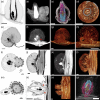Exploring the diversity of galls on Artemisia indica induced by Rhopalomyia species through morphological and transcriptome analyses
- PMID: 38962171
- PMCID: PMC11219473
- DOI: 10.1002/pld3.619
Exploring the diversity of galls on Artemisia indica induced by Rhopalomyia species through morphological and transcriptome analyses
Abstract
Plant galls generated by insects have highly organized structures, providing nutrients and shelter to the insects living within them. Most research on the physiological and molecular mechanisms of gall development has focused on single galls. To understand the diversity of gall development, we examined five galls with different morphologies generated by distinct species of Rhopalomyia (gall midge; Diptera: Cecidomyiidae) on a single host plant of Artemisia indica var. maximowiczii (Asteraceae). Vasculature developed de novo within the galls, indicating active transport of nutrients between galls and the host plant. Each gall had a different pattern of vasculature and lignification, probably due to differences in the site of gall generation and the gall midge species. Transcriptome analysis indicated that photosynthetic and cell wall-related genes were down-regulated in leaf and stem galls, respectively, compared with control leaf and stem tissues, whereas genes involved in floral organ development were up-regulated in all types of galls, indicating that transformation from source to sink organs occurs during gall development. Our results help to understand the diversity of galls on a single herbaceous host plant.
Keywords: Artemisia indica; RNA sequencing; Rhopalomyia; gall; microCT.
© 2024 The Author(s). Plant Direct published by American Society of Plant Biologists and the Society for Experimental Biology and John Wiley & Sons Ltd.
Conflict of interest statement
The authors declare no competing or financial interests.
Figures





Similar articles
-
Comparative transcriptome analysis of galls from four different host plants suggests the molecular mechanism of gall development.PLoS One. 2019 Oct 24;14(10):e0223686. doi: 10.1371/journal.pone.0223686. eCollection 2019. PLoS One. 2019. PMID: 31647845 Free PMC article.
-
Phenotypic plasticity and similarity among gall morphotypes on a superhost, Baccharis reticularia (Asteraceae).Plant Biol (Stuttg). 2015 Mar;17(2):512-21. doi: 10.1111/plb.12232. Epub 2014 Aug 14. Plant Biol (Stuttg). 2015. PMID: 25124804
-
Rediscovery and identity of Pumilomyia protrahenda De Stefani (Diptera, Cecidomyiidae) in Sicily with redescription and reassessment of its taxonomic position.Zookeys. 2016 Sep 15;(617):129-37. doi: 10.3897/zookeys.617.9850. eCollection 2016. Zookeys. 2016. PMID: 27667957 Free PMC article.
-
Recent Progress Regarding the Molecular Aspects of Insect Gall Formation.Int J Mol Sci. 2021 Aug 30;22(17):9424. doi: 10.3390/ijms22179424. Int J Mol Sci. 2021. PMID: 34502330 Free PMC article. Review.
-
Manipulation of host plant cells and tissues by gall-inducing insects and adaptive strategies used by different feeding guilds.J Insect Physiol. 2016 Jan;84:103-113. doi: 10.1016/j.jinsphys.2015.11.012. Epub 2015 Nov 24. J Insect Physiol. 2016. PMID: 26620152 Review.
Cited by
-
Plant organ modulates morphological constraints of insect-induced galls: evidence from citizen science data.Sci Rep. 2025 Aug 19;15(1):30433. doi: 10.1038/s41598-025-15384-z. Sci Rep. 2025. PMID: 40830164 Free PMC article.
-
Morphological and Transcriptome Analysis of the Near-Threatened Orchid Habenaria radiata with Petals Shaped Like a Flying White Bird.Plants (Basel). 2025 Jan 28;14(3):393. doi: 10.3390/plants14030393. Plants (Basel). 2025. PMID: 39942954 Free PMC article.
References
-
- Bae, J. , & Jung, S. (2020). First record of the genus Aprostocetus (Hymenoptera: Eulophidae) from Korea with the description of a new species: An inquiline of Rhopalomyia giraldii (Diptera: Cecidomyiidae) including galls on Artemisia princeps (Asterales: Asteraceae). Journal of Asia‐Pacific Entomology, 23, 923–929. 10.1016/j.aspen.2020.07.003 - DOI
-
- Barnewall, E. C. , & De Clearck‐Floate, R. A. (2012). A preliminary histological investigation of gall induction in an unconventional galling system. Arthropod‐Plant Interactions, 6, 449–459. 10.1007/s11829-012-9193-4 - DOI
LinkOut - more resources
Full Text Sources

